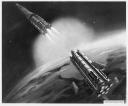It’s in the nature of a business enterprise to try to sell as much of their product as they can. This means trying to open new markets… roles your existing products may not have originally been designed for. United Technologies tried to do that in the mid 1960’s with a series of concepts for launch vehicles using derivatives of their UA-1205 solid rocket booster for the Titan. Instead of simply being boosters, though, the solids were intended to be complete stages, and in some cases the entire vehicle. Shown here is a Saturn-class booster that uses solids for the first and second stages, with a small liquid third stage to orbit an Apollo command and service module. The perceived advantage of a system like this over a conventional Saturn was faster availability… like a Minuteman ICBM, most of the vehicle would be ready to go at a moments notice. But NASA didn’t need that, and the USAF seemed unimpressed.
3 Responses to “All-Solid Saturn”
Sorry, the comment form is closed at this time.


Looks sort of like a solid fuel variant of the Soviet UR-700 design.
This thing would have been mighty heavy to transport to the launch pad.
I looked up the weight of the UA-1205’s (498,758 lb. each) so that first stage alone is going to weigh right near four million pounds with eight of them on it; toss in a second stage of around what ? One million pounds? …and you can see why there would be limited enthusiasm for moving this beast around.
(Empty, the first three stages of a Saturn V weighed only around 414,000 pounds.)
You’d either have to stack the whole thing bit-by-bit on the pad, or bring it to the pad on a large barge of some sort.
It would have been assembled on the pad, and then just sorta left there until needed. This would imply the need for probably several such pads, something I’m sure the USAF and NASA were thrilled about.
[…] that was designed to use nothing but solid rocket motors. Such things have been designed from time to time… but never as downright butt-ugly as this horrible […]